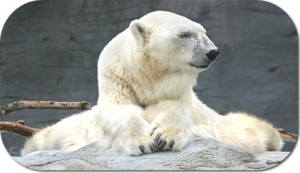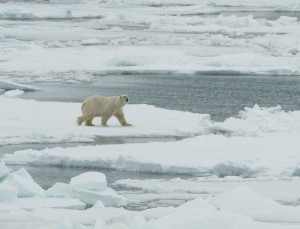Worldwide, there are dozens of different names used to refer to the great white bear. However the scientific name is Ursus maritimus, which means sea bear. Polar bears are classified as marine mammals, along with creatures such as whales, dolphins and seals. They have a lifespan of roughly 25 years in the wild, however this increases to up to around 35 years in captivity, with 42 year old Debby being recognized as the world’s oldest living polar bear by the Guinness book of world records when she died in 2008.

Bears in the wild
Female polar bears are pregnant for about 8 months. In the wild, bears that have mated will usually feed heavily, gaining up to 200 pounds before digging a maternity pen deep into the snow. Within this pen they will usually give birth to 1-3 blind, toothless, and almost hairless cubs, which weigh a mere 1 pound and depend entirely on their mother for food and warmth. The mother and cubs will remain in the den for 3-4 months, and a cub will remain with its mother for up to 2.5 years.
Polar bears have the largest habitat range of all land mammals, ranging across territory owned by Canada, the United States, Russia, Sweden, Finland, Norway and Denmark. An individual bear can have a home range of up to a few hundred miles; however this can be larger depending on the population and distribution of seals in the area, the main food source for wild bears. Further, polar bears are extremely well adapted to the harsh cold weather of the arctic. They have black skin which along with two layers of thick fur and thick layers of fat allows them to efficiently maintain their body temperature in the harsh arctic cold, which can reach temperatures as low as -45 degrees Celsius. They are also fantastic swimmers, and have been tracked to swim continuously for up to 100km at speeds of up to 10km/h. They have reach depths of up to 15 feet, and remain underwater for up to two minutes.

Species at Risk
Polar Bears have no natural enemies. They are at the top of the food chain, and play a vital role in maintaining seal populations and controlling other aspects of the arctic ecosystem. The only enemy that polar bears need to worry about is humans. Humans have had detrimental effects on polar bear populations in many ways over the years. In the past, poaching polar bears was a serious issue, which is now addressed through various agreements that protect most polar bears. Global warming, however, is considered the most serious and long term threat to polar bears and their habitat today. Global warming is causing the arctic ice packs to melt. Polar bears depend on these ice packs in order to hunt and to build dens, and often have to travel farther and work harder for food and appropriate places to dig a maternity den, having a detrimental effect on the species. In 2011, polar bears were listed under the Species at Risk Act in Canada, a domestic legislation with the goal of helping to conserve wildlife in Canada.
It is commonly understood that keeping endangered and at risk animals, such as the polar bear, in zoos, is an ideal way to preserve their species and their livelihood. However, it is important to understand and consider the negative implications that captivity can have on polar bears. These issues lead many to wonder whether the end really justifies the means.